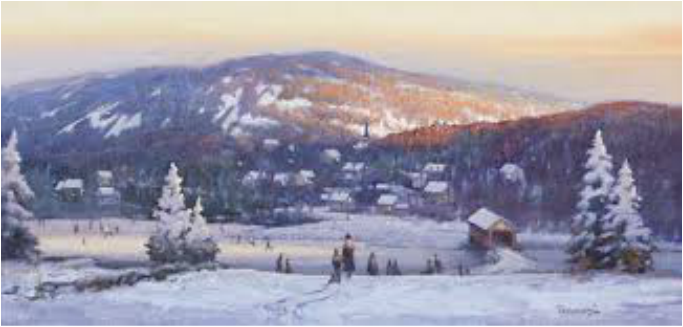The New England Colonies, comprising Massachusetts, Connecticut, Rhode Island, and New Hampshire, present a fascinating study in climate patterns, particularly reflecting its historic weather phenomena and notorious winters. This region, characterized by its distinct seasons, offers a rich tapestry of climatic contrasts that influenced not only the daily lives of its early inhabitants but also their agricultural practices, settlement patterns, and overall survival strategies.
Located in the northeastern corner of the United States, the New England Colonies experience a humid continental climate. This climatic classification is marked by four distinct seasons, each with its own peculiar characteristics. Winters are often severe, accompanied by heavy snowfall, while summers are typically warm and humid. These contrasts can ignite one’s imagination about the resilience and adaptability of both the early settlers and their descendants.
Winter in New England is nothing short of legendary. The coldest months, particularly January and February, often feature temperatures that plunge significantly below freezing, sometimes dipping to 20 degrees Fahrenheit or lower. The frigid air masses that sweep down from Canada result in brutal wind chills, exacerbating the already harsh conditions. Snowstorms, known locally as nor’easters, can deposit several feet of snow in a single event. These storms not only challenge the endurance of the local populace but also necessitate a communal approach to survival. Townsfolk would band together to clear roads, ensuring transportation and trade could continue, which in turn helped to solidify community bonds.
The impact of harsh winters extended beyond mere inconvenience, dictating the agricultural calendar and food security in the region. The long growing season—averaging only about 150 days—created a reliance on hardy crops such as corn, squash, and beans, commonly known as the Three Sisters. The shortening of the growing season due to cold temperatures made it paramount for settlers to develop ingenious preservation techniques. Canning, salting, and drying were not just methods for storing food; they were lifelines that sustained families through the long winter months.
Springtime brings a dramatic transformation as warmer temperatures thaw the icy grip of winter. The region awakens with a riot of color as perennial flora bursts into bloom. This season, however, also brings volatility in weather patterns. While some days are balmy and inviting, others can evoke memories of winter’s chill with unexpected snowfalls or gusty winds. The settlers learned to acclimatize to this unpredictability, a lesson that emphasizes flexibility in planning and preparation.
Summers in New England are often idyllic, boasting warm temperatures and ample rainfall that create rich conditions for crops. Temperatures can hover in the mid-70s to low-90s Fahrenheit, with humidity making the air feel even warmer. Consequently, this period of warmth became a critical time for agricultural activities. The vibrancy of summer also presented a stark contrast to the previous winter’s austerity. Minutes spent admiring serene lake views or lush green fields were earned through the hard labor of the preceding seasons. The duality of New England’s climate illustrates the cyclical nature of life; prosperity is frequently tempered by adversity.
However, New England’s climate also holds secrets beyond its immediate face. The transition into autumn heralds a striking metamorphosis as the region’s extensive deciduous forests transition into vivid shades of orange, red, and gold. The phenomenon, known as fall foliage, attracts tourists from around the world and showcases the breathtaking beauty inherent in the region’s climatic conditions. Simultaneously, this season serves as a prelude to the harsh winters ahead and signals a shift in agricultural practices as settlers prepare their lands for the cold months.
Analyzing the climate of the New England Colonies unveils the intricate relationship between weather patterns and human life over centuries. Each season not only defined the rhythms of the natural world but also sculpted the culture and traditions of the area’s inhabitants. The tales of survival during frigid winters or bountiful harvests in temperate summers are interwoven with the fabric of New England’s identity.
The lessons embedded within the climate narratives of New England extend beyond mere historical curiosity. Today, as the specter of climate change looms large, understanding the historical climate patterns offers crucial insights. The stark realities of winter, predicted to become warmer yet wetter, pose significant challenges not only for communities that honor traditional practices but for local ecosystems that thrive under precise climatic conditions.
As inhabitants of this planet, the onus lies upon us to draw parallels and learn from these historical climates. The climate in the New England Colonies teaches the principles of adaptability and resilience. If we apply these insights to contemporary climate challenges, we may cultivate more sustainable futures for ourselves and the ecosystems that envelop us. The echoes of winter storms, summer bounties, and autumnal transformations remind us that while we may grapple with fluctuating weather patterns, our interconnected journeys with the environment demand both reverence and active stewardship.
In conclusion, the climate of the New England Colonies symbolizes a rich confluence of severity and beauty, a duality that forms a vital part of our collective consciousness. Every snowflake that falls holds stories of struggle and perseverance, creating a mosaic of human experience shaped by the inherent unpredictability of nature. To acknowledge this rich history is to honor the past and pivot towards a more sustainable future, while inviting an exploration of the profound complexities of our ever-shifting climate.








